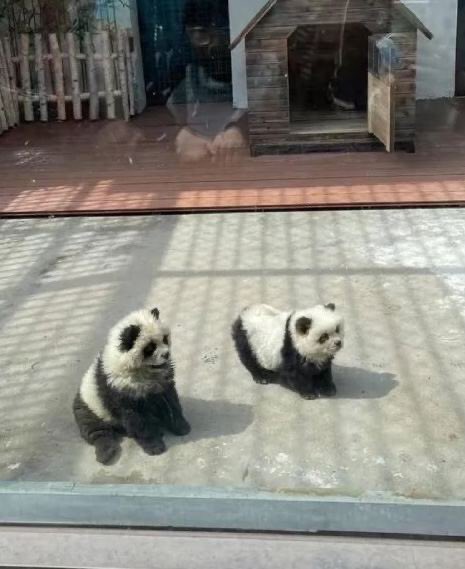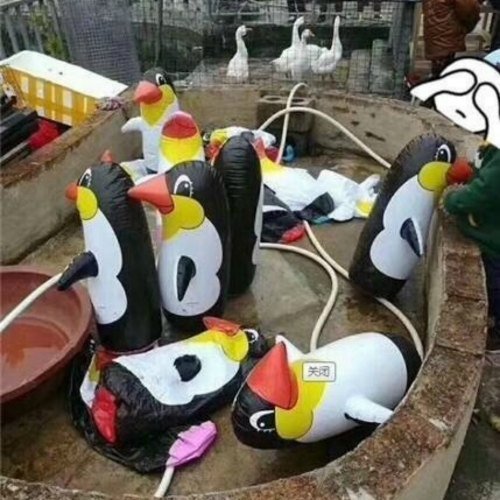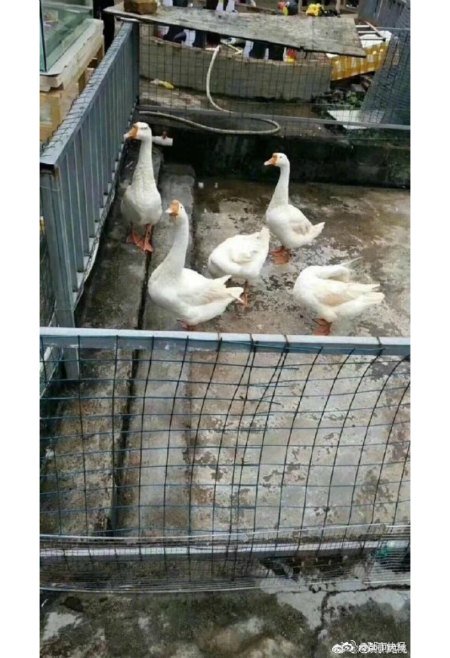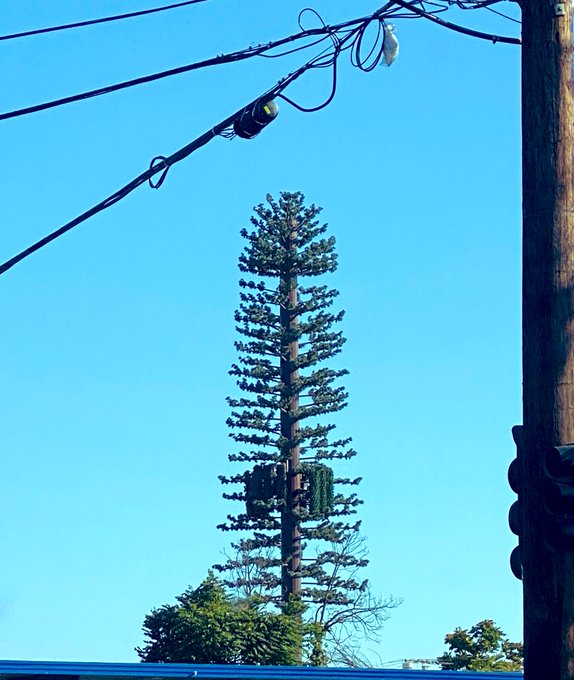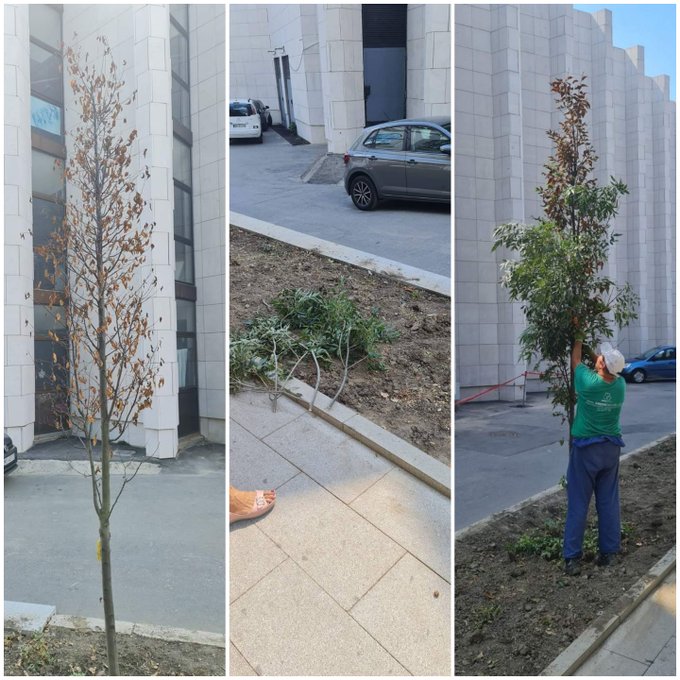From a hollow hill propped up by wooden beams, to a mountain peak that’s nothing but a façade of brick and steel, sometimes, nature isn’t quite as natural as it first appears. Let's peel back the mirage and uncover the times nature was fake!
Fake Chinese Mountain
Shenzen in southeastern China is overlooked by the towering Wutong Mountain. Standing at over 3,000 feet tall, it’s the biggest mountain in the region, with hikers having to suffer a grueling 4 hour ascent to scale this large landform.
Still, it’s more than worth it. The summit of Wutong Mountain rewards anyone that climbs up it with some breath-taking views of Shenzen. That’s not the only reason hikers struggle up this mountain, though. Also at the summit is this large boulder. Known as the “First Peak of Pengcheng”, it has become a must-snap photo op for hikers eager to prove they made it to the top. However, what all those tourists probably didn’t know was that this boulder is in fact,
completely fake. Back in 2024, two curious hikers defied warning signs that declared the summit off-limits due to “safety renovations.” Expecting to see some minor construction work, maybe the installation of safety barriers or improved pathways, they stumbled upon something far more bizarre. The legendary First Peak of Pengcheng had a large hole in it, exposing a hollow inner structure. Instead of solid rock, they found bricks, steel reinforcements, and metal wiring, exposing this so-called "natural landmark" as nothing more than a giant cement prop.
Rock on popular Chinese mountain exposed as fake, shocking visitors by South China Morning Post After the hikers posted the revelation online, the Wutong Mountain Scenic Area Management Office admitted that the boulder was indeed fake. They announced that that it was constructed back in 2004, using reinforced steel and cement to mimic natural stone. Presumably, the landmark was constructed to enhance the scenic appeal of the mountain’s highest point and encourage more mountaineers to trek up its summit. Which raises the question: Didn’t anyone wonder how a massive boulder suddenly "appeared" at the summit of this mountain back in 2004? Whatever the case, the fake peak isn’t going anywhere soon. Officials rushed to reinforce and repair the structure by the end of 2024, and anyone keen to check out this quirk will be glad to know it still remains at the summit of Wutong Mountain today.
China Spray-Paints A Mountain Green
We couldn’t talk about pretend peaks without mentioning one of China’s most infamous landscape makeovers, the Laoshou Mountain! Found in the southwest of the country, around 750 miles west of Shenzen, this place was an eyesore for decades, after years of quarrying exposed barren rock on the 30,000 square-foot face of a previously lush, green mountainside.
However, in 2006 villagers in the area were left scratching their heads when they saw that the previously untidy and rugged mountainside had been transformed. Now it had the same lush, green features as the rest of the mountain. Had nature suddenly decided to heal itself overnight? Did a miraculous forest suddenly sprout from the rock? Not quite.
Instead workers
painted the entire mountainside green! This $70,000 paint job left locals furious. Not just due to the cost, but because a coat of paint was chosen over real environmental restoration. Workers, who started painting Laoshou Mountain in August, admitted they were simply following county government orders, even though they weren’t told why. The most likely explanation? A quick-and-easy attempt to meet national environmental targets and appease inspections by superior officers without actually planting a single tree. After all, just a year earlier in 2005, China introduced its 11th Five-Year Plan, marking a significant shift towards sustainable development and environmental protection. Parts of these plans included increasing forest coverage in the country. So, chances are, local government officials sanctioned the painting of the barren mountainside as a quick and easy way to fool any inspectors.

Clearly the spray-paint shortcut has become a bit of a craze in China in recent years. Over in Chongqing one man, by the name of Yang Zhigang, decided to give his view an upgrade by
painting a nearby cliff face. Zhigang was tired of looking out of his window at a 3,000-foot barren cliff. So, of course, he decided to hire a team of workers to paint the cliffside green for him.
Locals said workers spent more than a week painting the middle section of the cliff face green while they were attached to safety ropes. But unlike Laoshou Mountain, this wasn’t about fooling inspectors or meeting environmental regulations. Zhigang didn’t even own the cliff. Instead he requested the paint job because the barren cliff was affecting his family’s feng shui. Feng shui is an ancient Chinese concept that focuses on creating harmony in your surroundings to bring good fortune. Additionally, in Feng Shui, green is supposed to promote growth and renewal. Mr. Zhigang’s growth and renewal may have improved, I can’t say the same for that poor, painted cliff, though!
Fake Waterfalls
China is home to some of the world’s most breathtaking natural wonders, and the Yuntai Mountain Waterfall in Henan province has long been one of them, or so people thought.
Yuntai mountain waterfall in the abundant water period is magnificent by Travel Luoyang With an impressive 1,030-foot drop, it has been hailed as Asia’s tallest uninterrupted waterfall, attracting countless sightseers eager to witness its majestic cascade. But as it turns out, this mighty wonder isn’t quite as natural as it seems.
Back in 2024, one hiker was scaling up the Yuntai Mountain. On their trek upwards they uncovered this strange sight. As they scaled higher, they spotted hidden pipes carved into the rock face, which fed water straight into the "natural" waterfall.
Tourist discovers waterfall in China supplied through pipes by South China Morning Post After footage of the fake flow was seen millions of times on social media, government officials were sent to the Yuntai tourism park to investigate. After receiving a stern telling off, the park later released a statement, saying they
made the "small enhancement" during the dry season to ensure that visitors’ trip to see "Asia’s tallest uninterrupted waterfall" was a worthwhile experience. While most of us would agree that a weaker waterfall is just part of nature’s natural cycle, clearly in China, some tourism parks are more interested in perfect presentation over authenticity. But if you thought Yuntai Mountain Waterfall was artificial, you’ve not seen anything yet! The Urumqi National Park nestled in northern China is full of pristine nature with picturesque streams, lush greenery, and stunning landscapes. But apparently, that ain’t enough. That’s because in 2024, what became known as the
curtain waterfall was put up in a scenic spot in this park.
It wasn’t a natural cascade, not even a piped-in enhancement, but a giant printed poster of a waterfall, put up for visitors to pose in front of. To further enhance it, a pathetically thin trickle of water was pumped over the top to create an unconvincing flow effect. If all that wasn’t unrealistic enough, giant Chinese characters were printed across the middle of the poster. Nothing screams natural wonder like a massive billboard waterfall with text written across it! Wouldn’t a picture in front of the natural beauty and surroundings, rather than a poster of a waterfall with some water sadly trickling down result in a better photo? Unsurprisingly, the complaints came flooding in, forcing the Urumqi Culture and Tourism Bureau to remove the puzzling poster soon after it was initially constructed.
Hollow Hill
While Urumqi National Park’s fake waterfall might be a lazy attempt at fabricating nature, the same can’t be said for our next unnatural uncovering. In 2024, the Bureau of Exploration, an organization dedicated to discovering strange and forgotten locations that exist on the fringes of everyday reality, uploaded the freaky footage below.
The mountains are not real by Bureau of Exploration That really is a gigantic artificial hill. Standing at an estimated 50 feet tall, this massive mound looks surprisingly realistic from the outside. But step inside? It’s virtually empty. Instead of solid earth, its interior is hollow, held up by a framework of wooden beams, with only a few scattered construction materials lying around.
So, where exactly is this strange structure? Well, despite dozens of requests from eager explorers wanting to track it down, the Bureau of Exploration refuses to reveal its exact location, worried that if word gets out, people will flock to it and trash the place. So that remains a mystery, but what’s the point of this hollow hill in the first place? The theories range wildly, with some suggesting that this could be some elaborate movie set. It would make the perfect location for some post-apocalyptic blockbuster, wouldn’t it?

Others believe structures like this are built to improve the scenery for people living nearby, because, let’s be honest, a rolling hill looks a lot better than barren, boring terrain. But would anyone really go through the effort of building a full-on fake mini mountain just for aesthetics? Maybe this hollow hill could even be a relic of a long-abandoned military project. The spacious interior might’ve once housed a massive cannon, secret bunkers, or an underground weapons depot.
Zoos That Faked Its Animals
Trips to the zoo let us humans get up close and personal with some of nature’s most exotic creatures, from towering giraffes, to mighty gorillas, and majestic tigers.
Chinese zoo slammed for dyeing dogs’ fur in ‘tiger stripes’ by South China Morning Post
Why does that tiger in the clip above look so small? And so fluffy? Visitors to the Qinhu Bay Forest Animal Kingdom in Taizhou, eastern China, were left scratching their heads in January 2025 when they spotted what looked like an oddly tiny, extra-furry tiger prowling its enclosure. After being contacted by local media, the Qinhu Bay Forest Animal Kingdom confessed the animal was in fact, a Chow Chow dog that had been painted in black and orange stripes to give the
appearance of a tiger. Just a year earlier in 2024, footage emerged on social media of these suspicious-looking pandas over at Shanwei Zoo in southern China. After visitors publicized the ruse on social media, the organizers admitted they’d painted two Chow Chows with black and white markings. Those puppers can’t catch a break. But China aren’t the only ones guilty of filling their zoos with some deceitful residents. In 2018, a zoo in Cairo, Egypt, was
accused of trying to pass off donkeys as zebras.
Zoo in Egypt accused of painting donkeys to look like zebras by CBS News
Crazily enough, some zoos don’t even bother with live replacements. In 2017, China’s Guishan Zoo was advertised as a place where visitors could come and see rare and exotic animals. However, in reality, this place’s star attractions consisted of: geese, a tortoise, and, strangest of all,
inflatable penguins! Clearly, China’s got a thing for artificial animals. Back in 2017, an embarrassing exhibition was held at the North Yubei Dinosaur and Butterfly Park in Guanxi, southern China. The park promised visitors an enchanting experience, claiming that “tens of thousands of butterflies from far and wide” would gracefully flutter down and land on their fingertips. News flash: they didn’t! Not because the butterflies weren’t tame enough, but because, well, there were no butterflies at all! Instead, visitors arrived to find hundreds of fake,
plastic butterflies attached to sticks poking out the ground.
Chinese visitors felt cheated by fake butterfly exhibition - TomoNews by TomoNews US
Understandably, furious tourists who had traveled miles for this so-called butterfly paradise felt scammed. But instead of apologizing, one worker tried to justify it, reportedly saying: why can’t a plastic butterfly land on your finger? Needless to say, the butterfly exhibition was a total disaster, and with no real butterflies in sight, it’s safe to say this attraction was a flutter fraud.
Robo-Shark
In October 2024, after five long years of renovations, Xiaomeisha Ocean World in Shenzhen finally reopened its doors. In the first week alone, as many as 100,000 visitors flocked to the sea park to gaze at the marine marvels. One of the biggest draws? A massive tank, teeming with fish and a beastly whale shark!
From a distance, the creature looked awe-inspiring, gliding effortlessly through the water like the gentle giant of the sea it’s known to be. But as onlookers got closer they spotted gaps in the creature’s torso where segments had been clearly connected. Turns out this wasn’t a real whale shark at all, but an underwater robot.
Fake whale shark in aquarium in China angers visitors by South China Morning Post Measuring 16 feet long and weighing over half a ton, the colossal robot can swim, turn, float and dive thanks to its mechanical fins. Impressive as that sounds,
many visitors felt short-changed after discovering the aquarium’s star attraction was a fake. In fairness, tickets to the aquarium were $30, while Xiamoeisha Ocean World failed to mention that it’s headline feature was a robotic replica. Still, Xiaomeisha Ocean World defended their decision. Whale sharks struggle in captivity. Growing up to 60 feet long, and the fact they’re migratory animals, travelling thousands of miles in the wild, means that no tank is big enough for them. These guys rarely survive beyond 5 years in aquariums, whereas they can live up to 130 years in the wild.
Because of these ethical concerns, China officially banned the trade of whale sharks in 2019, meaning aquariums could no longer capture and display live specimens. So, with no real whale sharks left to showcase, Xiaomeisha Ocean World turned to robotics instead. That’s as good a reason as any to "fake" nature.
Spray-Painting Grass Green
You’ve heard the saying the grass is always greener on the other side? Well, it seems like officials in Chengdu, China, took that way too literally. In 2013, Chengdu was set to host a prestigious global business forum, but there was one tiny problem: the city wasn’t exactly looking its best. Large patches of dead, yellowing grass lined the roads. But fear not, because the local government authorities had a plan.
You’d think they’d sow new grass seed to improve the appearance of the city’s lawns, but no! Instead, city workers were caught coating the withered lawns with a
mysterious green dye, turning the yellowing verges into an instant emerald paradise.
Spray painted grass in China by silvan500 So, what exactly were they spraying? Reportedly, the stuff is Top Green Turf Greening Agent, which last for up to 14 weeks, isn’t washed away by the rain, and even turns the soil green! Spraying the grass and soil green sounds like a sure-fire way to destroy the environment. However, a salesman for Top Green claimed the dye wasn’t toxic. In fact, the Chengdu Landscaping Department even said the spray was made up of a green-colored nutrient fluid that contains a fertilizer, improving the grass’ health, frost-resistance and appearance. Still, something tells me not everyone in Chengdu was thrilled about their city’s new artificial glow-up.
Snow Village Using Fake Snow
Bright green grass isn’t the only part of nature that’s been artificially enhanced in Chengdu. In January 2025, Chengdu Snow Village opened to the public, promising a picturesque winter wonderland just in time for Lunar New Year.
Advertisements showcased charming, snow-covered cabins, inviting tourists to experience a magical frozen escape. Sadly for the event organizers, mother nature didn’t get the memo. Unseasonably warm weather meant there was zero snowfall, which, as you might imagine, is a bit of an issue for a snow-themed attraction. However, rather than cancel the event, organizers got too creative; they completely faked it. They decided to just make their own snow. White sheets were stapled to cabin roofs, white sand and large cotton wool sheets were scattered across the ground, while a soapy foam drifted through the air. Forget Winter Wonderland, this was Winter Wasteland. Surprise surprise, it didn’t take visitors to the Chengdu Snow Village long to realize that the
snow was fake, as cotton was scattered across brown fields, and white, wooly sheets hung off barren branches. Complaints came snowballing in and when an on-site investigation confirmed the reports, Chengdu Snow Village shut down shortly after. That’s got to go down as the world’s biggest white lie!
Cell Tower Trees
In Collier County, Florida, one tree stands out from the rest, literally! Though plenty of decently-sized trees dot the green spaces here, the shrub that really catches the eye is a ginormous 147-foot tall beast of a tree.
Cell phone tower disguised as tree towers over patch of Collier County forest by Gulf Coast News
For reference, that’s close to the height of Nelson’s Column in London! Though it might be hard to tell at first sight, not everything is as it first seems with this tall tree. Unlike natural trees, which have irregular branch patterns and varying foliage density, this tree’s uniformly arranged, while its bark also looks to be bolted together. So what’s going on? Is this some sort of spying tree used to eavesdrop in on people’s conversations? Thankfully not. This is actually a cell tower tree. Sounds strange, but let me explain. With the rise of mobile phones in the 1980s, towns were soon cluttered with towering network masts. Unsurprisingly, these large, looming cellular towers were an eyesore to nearby residents. As a result, various camouflage techniques emerged, with towers hidden on church steeples, or water towers. Then, by the 1990s, a company called Larson Camouflage built a fake pine tower in Denver, disguising the cellular tower in the form of a tree. Clearly the idea stuck, with around 2,000 of these phony trees dotted around the U.S today. Still, there’s one problem with this tree approach, they’re not exactly that realistic! The towers are build to hold antennas higher than surrounding structures to ensure good reception, meaning these things have to be taller than whatever else is nearby. Hence why you’ll see these laughably large pine or palm trees.
For what it’s worth, my personal favorite are these colossal cacti dotted around the deserts of the southwestern U.S. Next time you’re scrolling through social media while in the middle of nowhere, spare a thought for that formidable foliage!
Novi Sad's Fake Trees
On the topic of tampered trees, let’s take a trip to Serbia, where officials found a rather peculiar way to green up the scenery. Back in 2022, Serbia president, Aleksandar Vučić was set to visit Novi Sad, a city in the north of the country. Prior to the president’s arrival, workers were busy making the city look as presentable as possible, cleaning sidewalks, removing graffiti, and giving the trees a green glow-up.
Before Vucic’s visit, workers were found clamping fresh, green branches onto dry, leafless trees near the Serbian National Theater building in the center of the city.
While this strange sight was undoubtedly used to present a more vibrant and well-maintained environment for the president’s visit, it’s still a head-scratching approach. Though these quick fixes may fool a few, they come with long-term consequences. Attaching plastic or artificially placed foliage can interfere with tree growth, and block natural sunlight, meaning these shrubs continue to struggle. Instead of relying on last-minute, artificial fixes, wouldn’t it have been better to plant more resilient, evergreen shrubs that can withstand harsh conditions? That way, rather than worry about barren branches, Novi Sad could have healthy, happy trees all year round. Plus, think about how many staples they’d save!
Cloud Seeding
May 1st 2016 was a public holiday in Russia, known locally as International Worker’s Day. Though rain was predicted for Moscow, the day stayed largely dry and sunny. You’d think it was because a pure stroke of meteorological luck, but this wasn’t fortune, it was planned.
To ensure clear skies for the celebrations, the Russian government reportedly spent $1.3 million to disperse the rain clouds over Moscow. So, how did they do it? Launch a giant sky vacuum to suck them out the sky? Zap them into oblivion with some lethal lasers? Not exactly. Instead, they used a type of weather modification, known as cloud seeding. Chemicals like silver iodide, potassium chloride and sodium chloride are released up into the clouds, either from planes flying overhead, or by firing small rockets containing the chemicals. When these particles make their way into clouds, they attract moisture, causing water droplets to fall from the cloud as precipitation, dissipating them in the process. By doing this before the holiday, Russian authorities cleared the skies in advance, ensuring perfect weather for their celebrations.

But clearing the skies isn’t the only use for cloud seeding. All around the world, countries have used this weather modification to ensure heavier rainfall. Nine states in the U.S actively use cloud seeding to boost precipitation. Take Texas, for example. The state’s blistering heat and low rainfall threaten crops, livestock, and deplete water levels. Yet, thanks to cloud seeding, precipitation has increased by about 10%, helping to combat drought conditions.
Saying that, cloud seeding doesn’t always go so smoothly. One of the first documented cases of cloud seeding came back in 1916. Back then San Diego was in the midst of a brutal drought, causing the city’s reservoir to run critically low. So, when a businessman by the name of Charles Hatfield claimed he could make it rain, the city council took him up on the peculiar proposal. For an agreed $10,000, Hatfield constructed a tower, before burning a secret cocktail of chemicals at the top of it, causing the fumes to rise up into the sky. Days later Hatfield’s prediction became true, it rained. In fact, it rained and rained, and rained some more! In all, some 17 inches of rainfall came down, causing landslides, flooding towns, and even led to the loss of life.
China's Artificial Moon
If you thought humanity’s ability to make it rain was impressive, wait until you read this: we’ve also had a go at building our own moon! Yes, back in 2022, it was announced that a team of Chinese scientists had built an artificial moon.
So, does that mean there’s a giant glowing sphere suspended over Beijing? Not quite. Instead, this "moon" is tucked away inside a research facility in Xuzhou, Jiangsu province in eastern China. While it might not light up the night sky, it’s still an incredible feat of engineering.
China has built an artificial moon facility to simulate Lunar conditions | 'Artificial Moon' by WION Rather than a full-scale lunar replica, the artificial moon is actually a small, 2-foot-wide test chamber housed in a vacuum-sealed room. Inside the room, scientists have create an artificial lunar landscape, made up of rocks and dust, mimicking the surface of the actual moon. By employing powerful magnets, the scientists are able to generate a magnetic field inside the chamber, counteracting the effect of gravity to replicate the moon’s gravitational conditions.
Strange as it sounds to set up a small gravity-less, moon landscape chamber, it’s all for good reason. China has set a goal of sending astronauts to the moon by 2030. This artificial moon is hoped to help this mission, allowing scientists to plan for conditions and prepare for building in low gravity. Essentially, this mini-moon is a high-tech testing ground, helping China plan for the real deal before humans set foot on the lunar surface. Safe to say China’s mock moon facility is out of this world! If you were amazed at these examples of when nature is fake, you might want to read about times we
controlled nature. Thanks for reading!









